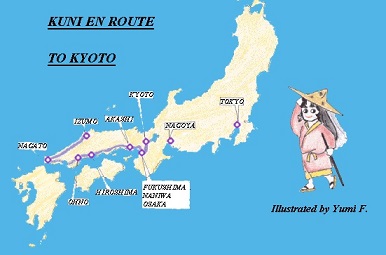KUNIJO KABUKI NOTES
IZUMO SHRINE
One of the most important Shinto shrines; located on the town of Taisha, Shimane Prefecture. The god of Izumo has traditionally been regarded as the god of marriage, good fortune, and agriculture.
KUNI
Also known as Izumo no Okuni. The supposed founder of the KABUKI theater.
In 1603, she performed at Kitano shrine and on the Shijo-Gawara (Fourth Street Dry River bed) of the river Kamogawa, in Kyoto. In fact, this date is generally regarded as the beginning of the kabuki tradition.
She had died in 1613 at the age of 87.
KABUKI
One of the three major classical theaters of Japan, together with the NO and the BUNRAKU puppet theater. The creation of kabuki is ascribed to Kuni, a maiden in service for Izumo Shrine.
HANAMI
Excursions and picnics for enjoying flowers, particularly cherry blossoms; one of the most popular events of the spring.
The subject of flower viewing has long held an important place in literature, and dance.
Popular viewing spots are as follows; Arashiyama, Yasaka shrine in Kyoto; Ueno, the river Sumidagawa, and Asukayama in Tokyo.
MT.HIEI
Mountain on the border between Kyoto and Shiga prefectures. This famous magnificent looking mountain was described in an old poem as "Miyako no Fuji" (The fuji of Kyoto).
On the eastern slope is the temple Enryakuji, an important center of the Tendai sect of Buddhism.
Height:848m (2,782ft).
MT.REIJU
A holly mountain in India. "Reiju" means a head of vulture.
OHARA
District in the northern part of the city of Kyoto. A mountain village in the Heian period (794-1185), it produced charcoal and firewood that women peddlers called OHARAME sold in the city. Today Ohara is a tourist area.
OSHIOYAMA
It is a grand mountain that rises up behind Oharano (Nishikyo-ku), in the south-west part of the city. In the Heian Era splendid pilgrimages went to this spot; the Buddhist worshippers, gazing at the sun sinking to the west of Mt.Oshioyama thought that the paradise of the West was there, and prayed fervently that they too might go to this western Paradise.
Height:642m (2,106ft).
KITANO
A Shito shrine in Kamigyo Ward, Kyoto; dedidated to the spirits of the scholar and court official SUGAWARA MICHIZANE(845-903). Shortly after his death, series of disasters struck the capital, Kyoto. It was soon believed that these misfortunes were the work of Michizane's dead spirit chafing at the injustices that he had suffered at the end of his career. To calm his spirit, the court conferred upon him the name Karai Tenjin (God of thunder).
The Kitano Shrine was built on the 44th anniversary of his death.
The ground contains an extensive glove of trees including hundreds of Japanese apricot, said to have been Michizane's favorite tree.
Nowadays, Kitano shrine is famous for its annual Baika (Japanese apricot) festival on Feb 25.
NEMBUTSU DANCE
Folk dance expressing the joyfulness of those whose faith assures them salvation, through singing of the Buddha AMIDA's name.
It is said that the monk, Kuya (903-972) had started.
NAGOYA SANZA
It is said that he was a joint actor to Kuni or her husband, but the details remain uncertain.
JO-RURI
Form of dramatic narrative chanting to Shamisen accompaniment that is commonly associated with the Bunraku puppet theater. It was flourished during the Edo period(1600-1868).
Chikamatsu Monzaemon was a great playwriter.
KOBATA
The place of the northern part of Uji city in Kyoto prefecture.

Last modified on 01/22/1996
